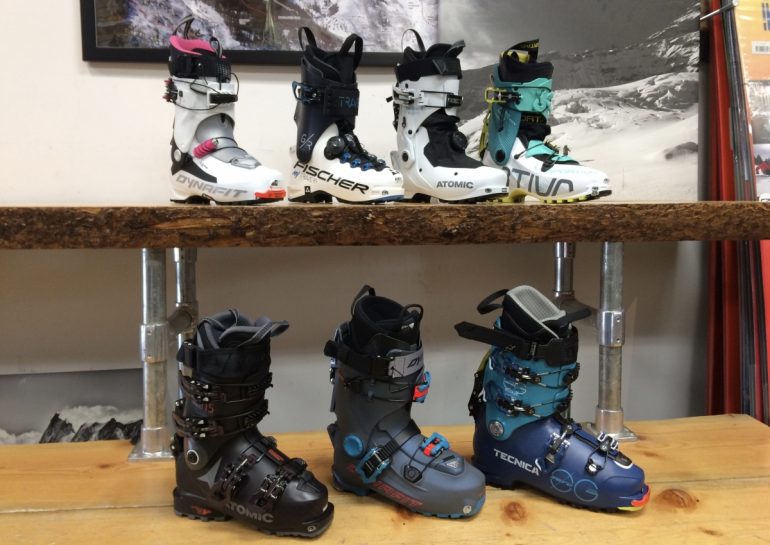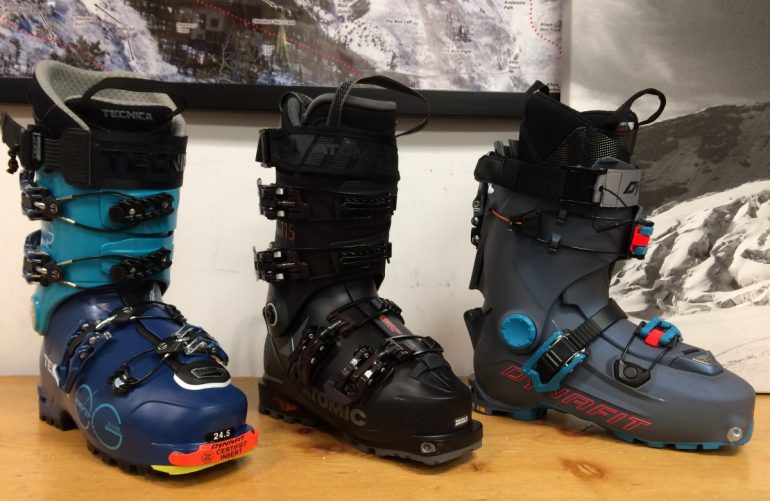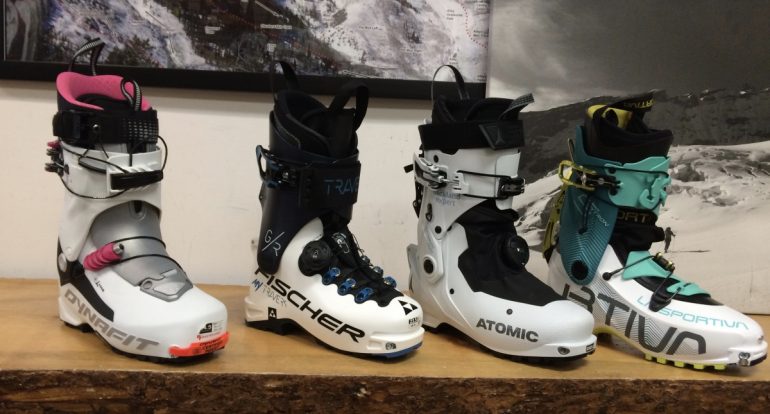
A small sampling of the women’s boots available, with updates since our last WildSnow women’s boot roundup in 2017-18.
WildSnow Women’s Boot Roundup 2019-20
It’s always easy to pick out the women’s boots among the men’s. The old adage ‘shrink it and pink it’ still holds true, though teal has taken the place of pink over the last few years, along with blue and purple. Welcome changes in my mind. Most women’s boots are simply variations on a men’s boots (or sometimes identical besides color), but the pool is at least growing. In the 2019-20 boot lineup, teal, purple and light blue are showing strong amidst the grays, blacks, oranges and blues on the boot wall.
Boot innovation typically doesn’t change drastically from year to year so there are only a few things to update since Julia Dubinina penned our last WildSnow women’s boot roundup in 2017-18. Check her post out for anything not on this list (I offer links to those boots at the bottom of each category). Included here are new and notable offerings for the lady ski tourer that have come out since, and that I could get my foot into. For 2020, there are two new boots on the block including Dynafit’s updated TLT8 Expedition CR W and Atomic’s Backland Expert W.
Since we’re still just scratching down the mountains here in Colorado, no on-snow testing has been done on these, but I did make an effort to get my foot into each one so as to give insights on fit, features, ease of use, etc. Unfortunately I couldn’t get into the TLT 8 and so I offer an overview and will update once I can get my hands on the actual boot.
A note about my feet: they are, by all seemingly rare accounts mostly normal. I wear a 9-9.5 shoe with my left foot closer to 9 and my right foot closer to 9.5. I’m relatively average width at 3.6 inches across the forefoot. No weird bumps to accommodate. I typically gravitate to SCARPA boots which often fit well out of the box in either performance oriented 24.5 or comfort oriented 25.5.
Additional note: due to different material sensitivities to temperature, it’s tough to really gauge stiffness within the context of a warm ski shop. I made an effort to feel out stiffness with each boot in ski mode with buckles tightened as they would be for descending, but take those observations with a grain of salt.
Freeride/All Mountain Boots

The growing category of stiffer, performance oriented options that can tour. Left to right: Tecnica Zero G Scout Tour W, Atomic Hawx Ultimate XTD W, Dynafit Hoji Pro Tour W.
Tecnica Zero G Tour Scout W
The Tecnica Zero G Tour Scout is a touring boot with downhill ambitions. It’s among the stiffer women’s boots out there and offers ISO 9523 soles with tech inserts, making it compatible with both tech bindings and MCN bindings like the Solomon Shift.
Features: Moldable shell, light magnesium buckles and an adjustable forward lean of 12 or 13 degrees. With 55 degree cuff articulation, the ROM leaves more freedom of movement to be desired, but it’d certainly get you up the hill. And yes, this boot is stiff. Fully buckled and in ski mode, I felt confident in the boot’s ability to charge.
Fit: Incredibly comfortable for out of box performance-oriented fit. No glaring pressure points. Supportive cradle around achilles and heel bulb. The width felt just right — snug but not numbingly so. If I were in the market for a double duty boot that erred toward on-piste time, this would be my top choice.
Weight: 1320g (25.5)
Flex: 115
Last Width: 99 mm
Material: Grilamid, PU cuff
Forward Lean: adjustable 12 or 13 degrees
Cuff Articulation: 55 degrees
Sole: ISO 9523 vibram w. Dynafit certified tec inserts
Buckles: 4 light magnesium buckles and power strap
Binding Compatibility: Tech, AT
Sizes available: 22.5-27.5
MSRP: $799
Atomic Hawx Ultra XTD 115 W
The Atomic Hawx Ultra XTD 115 has similar ambitions to the Zero G Scout and is a boot that’s been long favored among women and men alike who spend a lot of time on piste but also want to tour. It combines features from the Hawx and Atomic Backland (see below) for a high performance boot that’s home on groomers as well as skin tracks.
Features: 74 degrees cuff articulation, beefy 4 buckle construction with power strap and women’s specific cuff height and shape. It also offers a walk to ride sole and compatibility with tech and AT bindings. Once buckled up, it has the locked-in feel of a true alpine boot.
Fit: With its 98 mm last, the Hawx 115 is narrow and fits that way. Despite that I shell fit in the 24.5, my feet were screaming after only a few minutes. I’ve read a few other reports that this boot runs small (the 24.5 Backland Expert W, for instance, fit me perfect). The Hawx does however offer a moldable shell and memory foam liner to assist in creating the perfect fit. I’d pass on all the mods needed to make this one work but they’d be great for women with a low volume foot seeking a stiff touring boot that can double with resort duty.
Weight: 1360g (24.5)
Flex: 115
Last Width: 98mm
Material: Grilamid
Forward Lean: 15, 17 degrees
Cuff Articulation: 54 degrees
Sole: Skywalk WTR Sole
Buckles: 4 Buckle with Power Strap
Binding Compatibility: Tech, AT
Sizes available: 22/22.5 – 27.27.5
Shop for it.
Dynafit Hoji Pro Tour W
We’ve written at length about the Hoji Pro Tour boots here on WildSnow. Just as the men’s version is built with superior downhill performance in mind, so too is the women’s boot. In fact they’re basically the same boot. With 120 flex rating, this is the stiffest women’s boot on the wall. At 1320 grams, the Women’s Hoji Pro Tour weighs in alongside others in the category.
Features: I have to say, the Hoji lock is cool. No doubt it synched my foot into a bullet proof forward position from which it was not likely wriggle even the slightest bit out of. The boot offers a decent ROM at 55 degrees, though I found it much easier to actualize forward ROM than back. Dynafit’s speednose is a double edged sword — it limits binding compatibility but allows for more efficient stride.
Fit: The 24.5 was snug, perhaps a little too snug for daily touring. It did not feel as wide as its 103.5 last would suggest, though I did not try the next size up. (Side note on lasts: it’s rare that manufacturers list individual lasts as they correspond to individual boot sizes. It’s likely that the 103.5 listed is not true for the 24.5 I tried on). Once fully in ski mode, I noticed pressure under my arch and around the bulb of my heel. Both points could be relieved with a heat mold though.
Weight: 1320g (25.5)
Flex: 120
Last Width: 103.5mm
Material: Grilamid, fiberglass reinforcement
Forward Lean: 11 degrees
Cuff Articulation: 55
Sole: Pomoca
Buckles: 3 Buckle with Power Strap
Binding Compatibility: Tech
Sizes available: 22.5-27.5
MSRP: $799.99
Other options in this category include:
SCARPA Gea RS
La Sportiva Shadow
Dynafit Beast
Speed Touring/Ski Mountaineering

For ski touring and ski mountaineering, light boots that offer efficiency on the up with varying degrees of performance on the down. Left to right: Dynafit TLT7, Fischer My Travers, Atomic Backland Expert W, La Sportiva Sytron
Dynafit TLT8 CR Expedition W
Dynafit’s TLT boots have long been a standard ski touring slipper. In the latest iteration, the TLT8 Expedition CR, Dynafit shifts some of the focus from uphill performance to downhill while keeping the weight down. The boot carries over several key features from past iterations, including the speednose and two buckle system with the Ultra Lock closure, with a few improvements. The buckles have been simplified for easier usability, durability and a more secure fit. The boot is also stiffer to drive a bigger ski.
Features: Dynafit’s Ultra Lock system is one of my favorite features. It offers one buckle with two levers so you can open up the cuff with one and switch to ski or walk mode with the other. Set it, forget it, and flick it back and forth as needed. I’m excited to see improvements in the 4.0 version. While the speednose limits compatibility with bindings and crampons that require a toe bail, it offers more efficient roll-through on each stride.
Fit: I couldn’t get my foot into the new TLT 8 (yet) and will update once I do. I did speak with the folks at Dynafit, though who reported that upgrades from the TLT 7 to TLT 8 include tweaks in the lower and upper liner to better fit a woman’s foot and calf. They’ve also changed to boot tongue to provide a more adaptive fit across the instep, due to folks saying the previous lack of adjustability made for less secure skiing. Stay tuned for a more in depth look once I get the boot in hand (or foot…).
Weight: 1040g (25.5)
Flex: 110
Last Width: 103mm
Material: Grilamid
Forward Lean: 15, 18 Degrees
Cuff Articulation: 60
Sole: Pomoca
Buckles: 2 Buckles with Power Strap
Binding Compatibility: Tech
Sizes available: 23 – 27.5
MSRP: $749.95
Fischer My Travers
Fischer has had a great deal of success with their men’s Travers boot, though little has been said about the women’s. This boot is lightweight at 1029 grams and minimal. Fischer calls upon a Boa system to eliminate extra weight and potential pressure inconsistencies from buckles.
Features: The Fischer My Travers offers a whopping 80 degrees of articulation which gave me the sensation of walking around in a running shoe. Freedom of movement is no question here. This boot offers an overlap cuff along with a waterproof gator and Boa. This is definitely a softer, less downhill performance oriented ski mountaineering and touring boot and its lack of stiffness was notable while in ski mode.
Fit: Immediate comfort in the 24.5. Just for fun, I tried the My Travers on one foot and the Zero G on the other and honestly forgot the My Travers was on. That said, it’s a fairly roomy toe box that errs on the wider side. Personally, I’d be concerned about width after the liner had some time to pack out. I also noticed a pressure point directly beneath the Boa closure which rested just above my dorsalis pedalis artery leading me to actually be able to feel my pulse. Perhaps that could be alleviated with a heat mold, but it might just be the nature of that positioning. (Side note: I currently ski the Scarpa F1 and have not had issues with pressure from the Boa, likely due to the fact that it’s centered on the boot over the shell as opposed to being positioned off to the side).
Weight: 1029g (25.5)
Last Width: 100mm
Material: Grilamid
Forward Lean: 14 degrees
Cuff Articulation: 80
Sole: Touring Rubber
Buckles: 1 and Boa System
Binding Compatibility: Tech, AT
Sizes available: 23.5 – 27.5
MSRP: $799
Shop for it.
Atomic Backland Expert W
New for this season, the Backland Expert W draws on the popular Backland boot series with a few tweaks for women. This is a lightweight touring and ski mountaineering boot with a clear emphasis on uphill performance.
Features: The Boa closure over a soft gator allows for minimal adjustments and quick transitions between walk and ski mode. The light, narrow last gives feeling of a slipper. Exceptional ROM at 75. By and large, with it’s 95 flex rating, it’s on the softer side. I really had to crank top buckle to feel more secure in the boot which got me wondering: would I feel totally confident topping out a technical peak with sketchy rock moves in this boot? Yes. Would I feel equally confident descending a tight steep couloir in variable conditions in this boot? Depends on what ski is underfoot, but less so.
Fit: The 24/24.5 fit snug and near perfect right out of the box. I did have notable pressure on my right big toe (the larger foot) which could be easily molded out. Great comfort in heel cupping. Super soft liner, like, actually delightful to touch.
Weight: 1097g (26.5)
Flex: 95
Last Width: 98mm
Material: Polymide
Forward Lean: 13, 15, 17 Degrees
Cuff Articulation: 74
Sole: Skywalk Rubber Sole
Buckles: 1 Buckle and Boa System
Binding Compatibility: Tech
Sizes available: 22/22.5 – 25/25.5
MSRP: $725
Other favorites in this category:
Solomon MTN Explore W
La Sportiva Sparkle 2.0
SCOTT Celeste III
Race/Fitness
Nothing new to report this year. To date, the only true women’s race boot (or boot under 1000g) is the La Sportiva Sytron, which we just got in at HQ and will have a full review on later this season.
One major thing I noticed while trying on different boots is that last didn’t seem to influence fit width as much as I expected it would. There are many other factors like liner thickness and the way a boot scales down into the lower sizes that could contribute to this. I’m also keen to compare women’s and men’s boot boot fits and cuff heights for the next time around. Until then, happy boot hunting!
Manasseh Franklin is a writer, editor and big fan of walking uphill. She has an MFA in creative nonfiction and environment and natural resources from the University of Wyoming and especially enjoys writing about glaciers. Find her other work in Alpinist, Adventure Journal, Rock and Ice, Aspen Sojourner, AFAR, Trail Runner and Western Confluence.
